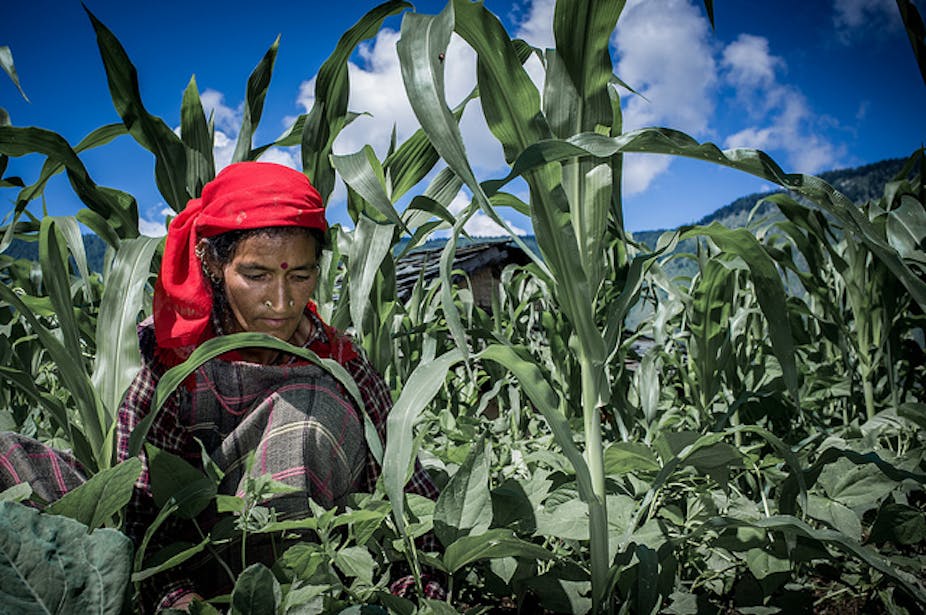Our modern food system is a double-edged sword: delivering chronic under-nutrition due to shortages of nutritious food, and chronic obesity due to overconsumption. In Australia, we’re living among 60% of adults and 25% of children who are overweight or obese. But if you live next door in Timor-Leste, you face a childhood stunting rate of 60%, due to malnutrition.
Recent estimates suggest that as much as 11% of gross national product in Africa and Asia is lost annually as a result of malnutrition. The economic costs of under-nutrition include direct costs such as the increased burden on the health-care system, and indirect costs of lost productivity.
We’re also increasingly realising that gender is a critical dimension to these nutritional issues – and addressing disparities in this area may be the key to improving nutrition in the developing world.
Changing the way we think about famine
For the greater part of the 20th century, undernourishment was misdiagnosed as a lack of food, and agricultural activity worked to rectify it by increasing food production and agricultural productivity. The yields of maize, wheat and rice all increased. But with increasing yields came decreased nutritional diversity.
From the late 1970s, and particularly after the seminal work on poverty and famines by Amartya Sen, malnutrition was linked to food security rather than food availability. The world has realised that increasing food production alone, while ignoring distributional issues, will not be sufficient to eradicate malnutrition, unless the poorest can access food readily.
It may come as a surprise that women comprise 43% of the agricultural labour force in developing countries and account for two-thirds of the world’s 600 million poor livestock keepers. In sub-Saharan African countries, women provide 60% to 80% of the labour for food production and most of the post-harvest management.
But women farmers’ yield is usually less than that of men because they are denied access to the same resources such as information, seeds and tools.

The UN Food and Agriculture Organization (FAO) has also found that female farmers receive only 5% of all agricultural extension services across 97 countries, and only 10% of total aid for agriculture, forestry and fishing goes to women.
The FAO says that given equal access to resources, women would achieve the same yield levels as men, boosting total agricultural output in developing countries by 2.5% to 4%. This additional yield could reduce the number of undernourished people in the world by 100 to 150 million or 12% to 17%.
Research also indicates that resources under the control of women are more likely to be used to support the education and nutrition of children.
So, what can we do?
While agriculturalists have been busy focusing on agricultural production, multilateral agencies such as the World Health Organization and UNICEF, the United Nations Children’s Fund, have been supporting a range of micronutrient fortification and supplementation efforts in many countries to improve human nutrition – with some success.
But the long-term sustainability of these interventions is being questioned by both donors and national ministries. As external donor funding phases out, many national governments have difficulty finding adequate funding to continue these programs.
National and multilateral agencies are seeking sustainable solutions to the food security challenge that will deliver better human nutrition through improved household income and dietary diversification.
As the human population increases and arable land becomes increasingly scarce, a spectrum of research activities is needed, rather than putting all of our eggs in the high-tech basket. Policy reforms, reducing food wastage and increased efficiency of smallholder farmers have a role to play and each will require a multidisciplinary approach to problem solving.
A new five-year project, in collaboration with the governments of Tanzania and Zambia, aims to do just this: strengthen household nutrition and reduce childhood stunting by building on women’s roles in poultry management and crop growth. This approach requires low investment and can contribute significantly to both poverty alleviation and food security.
Family poultry have a special place in food and nutrition security as they are owned by the majority of households and are frequently the only livestock under the control of women. Crops such as sunflower, millet and sorghum are often under women’s control and provide flexibility in the face of variable climate, a broader range of nutrients than hybrid maize and a way of managing farmer risk.
The lessons learnt and research findings generated will be a step in the right direction for global food security, which is based on good farming practises, implemented by well-informed and well-paid farmers. Gender equity is inherent in such measures, and will help us achieve sustainable food systems. It isn’t just an ethical move, it’s a smart one too.

